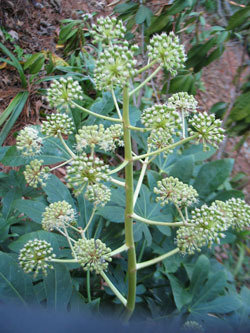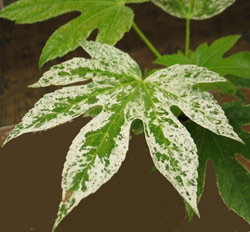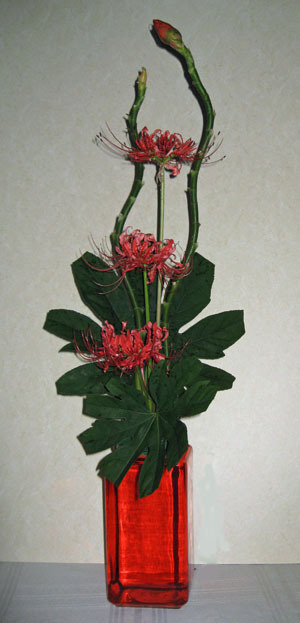





Fatsia japonica is a landscape shrub that adds a bold, tropical look to the landscape. Large 12-inch wide leaves liberally cover the plant. Gardeners and floral designers alike treasure the glossy, dark green leaves and the imposing presence that it lends to both landscapes and floral designs.
Fatsia japonica grows 8 to 12 feet tall and about as wide if left to its own devices. Long petioles hold 12-inch-wide, deeply lobed (palmate), slightly serrated leaves up and out. Adding interest in fall are ball-shaped clusters (umbels) of white flowers held above the foliage on white stalks. The flowers eventually give way to green, fleshy fruits that turn black at maturity. Stems are capable of growing quite tall, and most leaves are positioned at the top of the stem. The bare stem underneath the leaves is covered with leaf scars.
Cultural Preferences
Fatsia flourishes in slightly acid, rich, moist but well-drained soil in full to partial shade. Fertilize if leaves turn pale or yellow or otherwise indicate a nutritional deficiency. Although Fatsia is tolerant of heat, humidity, pollution, deer, and rabbits, it should be protected from harsh, drying wind and from burning sun.
Even though fatsia is capable of growing to 12 feet tall, many growers cut off the stalks long before they attain that stature. They become top heavy, and the weight of the leaves may cause the plant to lean or even fall to the ground. New stems are positioned right at the base of the tall stems just waiting to take their place. Cutting old stalks back to the ground rejuvenates the plant and makes it once again a young-looking, attractively rounded landscape specimen. Variegated forms are available. One attractive cultivar is aptly named ‘Spider Web'. 
Fatsia is easily propagated by stem (or stalk) cuttings. Simply cut the stalk into pieces about 9 inches long and place in damp soil. Use the young, upper part of the stem for propagation. The bottom, woody part is much harder to root. New plants can also be started from seeds.
Fatsia is reported to be hardy in USDA Zones 8-11. However, some of Dave's Garden readers have successfully grown it in Zone 7. Just remember in areas where it is marginally hardy to grow it in a protected place and to mulch it well to protect the roots from freezes. Gardeners farther north can grow it in containers, for which it is well suited. Many choose to grow this adaptable plant as a houseplant.
Fatsia is seldom bothered by diseases, but scale insects and mealybugs may occasionally attack. The presence of scale insects may be first noticed when small yellow spots appear on the leaf surface. An examination of the underside of the leaf will reveal many tiny scale insects that are fast attached and sucking the "lifeblood" out of the leaf. Sooty mold may grow in the honeydew secreted by these insects. Both can be controlled by systemic insecticides or by spraying with horticultural oil.
Uses in Floral Design
Floral designers find this plant indispensible, and it can usually be found growing in their gardens. The bold, glossy foliage makes a bold statement in a design just as it does in a landscape. The leathery leaves can be cut into any shape or configuration desired, and the cut edges do not turn dark. Leaves are long-lasting and are often the last part of a design to be discarded. The green or black berries are also useful, especially for small designs or for filling spaces in pavé and other very detailed designs.
The author's simple floral design on the right was made using 3 cut stems of Lycoris radiata, two stems of spiral ginger as line material, and two trimmed fatsia leaves for foliage. A clear container with colored water completes the design. All plant material was grown in the author's Zone 8b garden.
If you need a plant that will make a bold statement in a shady place, Fatsia may be just the thing. Try it at entries or on patios or decks in containers, as evergreen shrubs to frame your home, or underneath trees or other shady places to add a bit of distinction to your domain.
At a Glance
Scientific name: Fatsia japonica
Pronunciation: FAT-see-uh juh-PON-nick-uh
Common names: fatsia, Japanese aralia
Family: Araliaceae
USDA hardiness zones: (7) 8 through 11
Exposure: full shade to part shade
Size: 4-12 feet tall and wide
Origin: Japan
Copyright © www.100flowers.win Botanic Garden All Rights Reserved